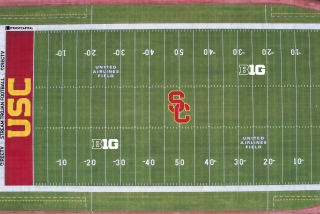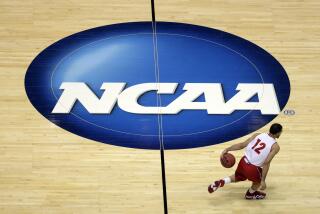When Logos Are a No-Go
Maria Sharapova giggled last month after winning the Acura Classic tennis tournament in Carlsbad and being handed the keys to a 2007 Acura.
“I don’t know what I can do with the car, because Range Rover is my sponsor,” Sharapova said. “Maybe I’ll just have to put it in the garage and leave it so Range Rover doesn’t get mad.”
The commercial plug prompted good-natured shouts from fans who were willing to take the upscale sport utility vehicle. It also left tournament sponsor Acura slightly red-faced and underscored the tension created when an athlete’s individual endorsement deals bump up against corporate sponsorships arranged by teams, leagues and venues.
Sharapova’s advertising gambit wasn’t a new tactic. During the late 1990s, a beach volleyball player infuriated tournament sponsor Coca-Cola by wearing a T-shirt emblazoned with a huge Pepsi logo. And similar sports marketing games now are underway at horse racing tracks, on European soccer pitches, during West Indies cricket matches and at NASCAR races.
“Organizations only have so much control over the deals that athletes can make,” said William Chipps, a senior editor with IEG Sponsorship Report, a Chicago market research firm. “What they can do is in some way set limitations on how athletes are using their [endorsed] products during sporting events. Sometimes, though, you can’t do anything about what an athlete says.”
Athletes have been shoving corporate logos into fans’ faces since at least 1968, when triple gold-medal winner Jean-Claude Killy infuriated Olympic purists by carrying his downhill skis -- with the manufacturer’s logo prominently displayed -- to post-race interviews during that year’s Winter Games.
Michael Jordan and other athletes with Nike endorsement deals upped the ante during the 1992 Summer Olympics when they pledged allegiance to their business partner by draping Old Glory over their shoulders to cover up a Reebok logo on the official team warmup suit.
Running back Reggie Bush didn’t bother with a coverup in August when he made his professional debut in an NFL exhibition game. The former USC star strapped on Adidas cleats for the game even though the NFL had licensed only three footwear providers -- Nike, Reebok and Under Armour. Though NFL players are free to wear whatever shoes they choose, competing logos must be covered.
Bush was assessed a $10,000 league fine for his dress code infraction, which was flagged by former NFL players whom the league hires to serve as its “fashion police.” It could be money well spent, according to market research firm Joyce Julius and Associates, which is based in Ann Arbor, Mich., and estimated the value of publicity for Adidas from the incident at about $100,000.
Adidas, which reportedly is paying Bush $1 million to wear its footwear and apparel, then managed some of its own fancy footwork. The company forged an agreement to become the NFL’s fourth authorized footwear partner, freeing Bush or any other player to wear shoes with the company’s logo.
Corporations seeking a place in the sports spotlight will spend $8.9 billion this year on sponsorships, according to the IEG Sponsorship Report. Two years ago, Forbes magazine estimated that the world’s 50 highest-paid athletes earned a cumulative $1.1 billion, with 40% of the money coming from endorsements.
The big paychecks are cut in the hopes of enjoying TV exposure like that created this summer when Andre Agassi’s U.S. Open run generated $2 million in media exposure for Adidas, which outfits the tennis player from head to toe.
But at times, fans and viewers are hit with conflicting messages.
Gatorade, for example, is the NBA’s official athletic beverage. PepsiCo, which owns the brand, also has struck deals to have the familiar orange lightning-bolt logo liberally displayed along team benches in 20 NBA arenas.
Players are restricted to Gatorade or water at such NBA functions as the annual All-Star game, but during the regular season, some teams allow athletes to consume their beverage of choice -- as long as competing logos aren’t displayed.
When Tracy McGrady of the Houston Rockets gets thirsty, he’ll drink from a plain water bottle or a Gatorade cup. “Gatorade is a big part of the NBA, but they can’t make me stop drinking what I want to drink,” said McGrady, who prefers Glaceau’s Vitamin Water -- a company in which he holds an equity stake.The issue of dueling drinks also surfaced in July when Tony Stewart won NASCAR’s Pepsi 400. The driver tumbled out of his car on Victory Lane and shouted out to a national television audience that Coca-Cola, one of his sponsors, “tastes a hell of a lot better” than the race sponsor’s cola.
Stewart’s ambush marketing might have left Pepsi executives seeing Coca-Cola red, but it wasn’t the first time a driver bumped into a NASCAR sponsor.
Until the racing circuit put its foot down a few years ago, some drivers were removing NASCAR sponsors’ signage from their cars to protect their own marketing deals.
No surprise that leagues, clubs and venues try to avoid commercial dust-ups by crafting contracts that spell out who can sell what.
Toyota, for example, is the official vehicle at the Del Mar racetrack, but when Dodge sponsors the Classic division of the venue’s Breeders’ Cup, Dodge’s signage is nowhere to be seen.
The Assn. of Volleyball Professionals player contract limits the number of advertising patches and tattoos that athletes can wear during matches -- though the league allows female athletes to negotiate for additional ad space because, as the contract notes, “men’s bottoms have more space available for patches than women’s bottoms.”
The AVP, along with other leagues, tries to protect major sponsors by guaranteeing them exclusivity in a given category -- say, footwear, which the volleyball league limits to its title sponsor, Crocs. Although jockeys have the right to advertise on tracks in California, they’re at odds with a Kentucky Horse Racing Authority rule that forces them to clear proposed advertising, worn on their britches and turtlenecks, with horse owners, the racing association and track stewards.
The racing authority maintains that the rule protects sponsorship deals structured for different races and meets. But jockeys maintain that the rule ignores their 1st Amendment right to free speech.
“I’d love to bring corporate America to the racing industry,” said Kent Desormeaux, one of three jockeys who face suspensions for wearing unauthorized advertising during the 2005 Kentucky Derby.
The commercial dispute also is evident overseas.
Cricket and soccer players are fighting for their right to strike individual endorsement deals. The West Indies Cricket Board recently quelled the threat of a player strike after the board replaced one cellphone company sponsor with another. Some players stuck with the old sponsor while the board demanded that they drop any conflicting endorsement deals. The two sides agreed to a compromise.
And last month, players with Nike shoe contracts threatened to strike after the German Football Assn. demanded that they wear Adidas gear on the field. This month, the association announced that players would be free to wear competing brands’ footwear during international play -- but they must wear Adidas apparel during practice sessions and Adidas shoes during other games.
Oddly enough, the action sports arena, which is populated by free spirits known for speaking their mind, largely has avoided the issue of dueling sponsorships. Riders occasionally are seen hefting a beverage that conflicts with one of the sport’s official sponsors.
“You occasionally see an individual [motocross] rider at odds with a motorcycle-sponsored team, but at the end of the day, both sides have a huge interest in accepting money so they almost never go head to head,” said Josh Swartz, chief operating officer of Wasserman Media Group, a Los Angeles-based sports marketing and athlete representation firm. “The equity is in the athlete in this sector, not generally in the team.”
*
Times staff writers Diane Pucin and Jim Peltz contributed to this report.
More to Read
Go beyond the scoreboard
Get the latest on L.A.'s teams in the daily Sports Report newsletter.
You may occasionally receive promotional content from the Los Angeles Times.










